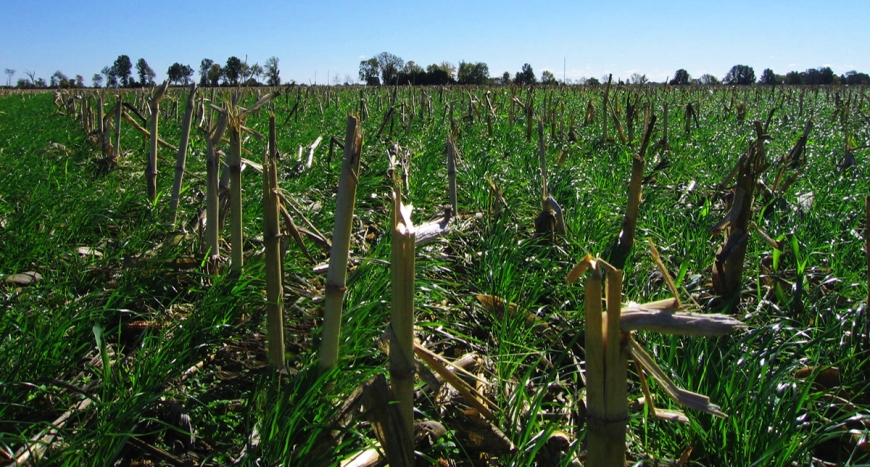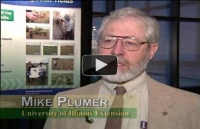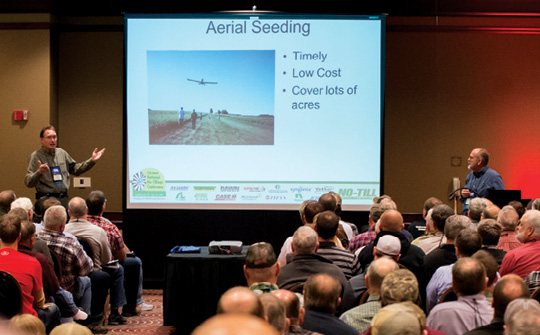Filling Some Legacy Shoes in Cover Crop Research
As a youngster, John Pike watched Mike Plumer excavate a small pit in a
cornfield not far from his own family farm in southern Illinois. Plumer, at the
time, was an Extension agent at the University of Illinois. “He was there to demonstrate how the fragipan
soil common to southern Illinois prevents healthy root growth and negatively
impacts crop yields,” John said. “The pit clearly showed corn roots hitting the
fragipan but not penetrating it.”
At the time, Plumer
hadn’t discovered how annual ryegrass, used as a cover crop, gradually breaks
down fragipan and allows deeper root growth. “But even then, before he made
that connection, his curiosity and deep conviction in conservation tillage made
a big impression on me,” John added.
That field day
demonstration stuck with John as he later attended college and followed in Plumer’s
footsteps at the U of Illinois, becoming an Extension agent and later a
research agronomist for the Department of Crop Sciences, in charge of research
station operations in the southern part of the state. “It was such a pleasure
to have the opportunity to know Mike as a friend and to work with him
professionally, before and after his retirement,” he said.
John’s career with
the university focused on soil fertility, nutrient management, and water
quality. Cover crop research became a significant part of that work. When the
university shut down four of its research stations, John started his own ag
consultancy as a research agronomist. And that, he said, led to “a more
flexible and comprehensive range of work,” a lot of which involves working
closely with researchers from other universities.
“Universities have
historically been a major source of innovation for the ag industry,” John
continued. “But with cover crop discoveries, it was largely the reverse, with
innovation coming from the field and gradually informing the universities to
backfill with research that quantified the benefits.”
He went on to
explain why. “Research involving cover crops is not always best suited to the small
plot design used on most university farms. Further, as it relates to cover crop
research specifically, the typical 3-year funding cycle common to many research
programs is not long enough to capture the cumulative impacts of a cover crop
system. The use of annual ryegrass as a
cover crop in fragipan soils is an example. While short-term benefits become
evident quickly, like erosion control and nitrogen recycling, the impacts of
ryegrass on fragipan soils are realized only over a longer timeframe; the
effect of annual ryegrass on fragipan becomes pronounced between the third and
fifth years, when corn crops show significant gains in rooting depth and
yield. So, funding a 3-year research
program might discount the true potential and lose out on some of the most remarkable
impacts.”
Given that the
cover crop revolution didn’t start on university farms, it’s more understandable
why some professors and Extension researchers were reluctant to sign on as early
cover crop advocates. In fact, some actively campaigned against annual ryegrass
because they feared the cover crop would create more headaches than benefits.
The reticence of
university researchers, however, did not deter farmers like Junior Upton (Springerton,
Illinois) and independent thinkers like Mike Plumer. Their on-farm discoveries of
annual ryegrass’ benefits in the mid-1990s won early support from Oregon ryegrass
seed growers as well as their Ryegrass Commission. A decade of replicated field
trials helped determine which annual ryegrass varieties were the most winter
hardy and which management practices were most effective for control of cover
crops with herbicides. The trials also attracted media attention and thus
increased university interest.
“Farmers change their
crop management practices only when the economic benefits can be demonstrated,”
said John, who has continued to farm his own acres as well. “Telling them about
soil health is secondary to economics. So, when they hear from their neighbor
or find out for themselves that cover crops can save you money or boost your
profits, they pay attention. Annual ryegrass does that by reducing erosion and
compaction, while boosting yields, improving water infiltration, and many other
things.”
So as Mike Plumer
retired, and passed away shortly thereafter, John has tried to continue some of
Mike’s projects and maintain relationships with many of his long-time
farmer/collaborators. “I like to think I’m
helping to keep the ball rolling,” he explained, “but it’ll take many more people
like me to move the ball as far down the field as Mike did. I’m just glad to make sure his efforts and
interests are continued, as we shared the same interests.”
The Ryegrass
Commission has hired John to further Plumer’s work, with Junior Upton and many
of the other growers Plumer attracted to cover crop usage. One of those happy
customers, Illinois farmer Marc Bremer, has been using annual ryegrass in rotation
between cash crops and grazing cattle for 15 years. On grazed pastures, he’s
seen corn yields increase to 230 bushels/acre and beans to 80 bu/ac. John’s research
will create data on the further reduction of fragipan on that farm over the
next five years, comparing grazed and un-grazed fields using annual ryegrass to
other acreage tilled in the old “conventional” way without cover crops.
In addition, John
will be following up with the University of Kentucky, as researcher Lloyd
Murdoch heads into retirement. John will further Murdoch’s work and provide
crucial location assistance to Dr. Claire Phillips, a scientist working with
USDA’s Agricultural Research Service in Ames, Iowa. “I’ll be monitoring their
test sites in southern Illinois,” John said, “including acreage owned by Junior
Upton.” “We’re placing field sensors to track hydrology in soils affected by
fragipan and gathering data on soils freed from compaction by using annual
ryegrass,” he explained.
“Water management
is critical in our region and, really, in most parts of the world as well. Reducing runoff, soil erosion and related
nutrient loss is a major factor in the efficiency of our mostly unirrigated
row-cropping systems,” John added. “Employing annual ryegrass as a component of
cover crop programs helps to keep soil in place, improve water infiltration
rates and significantly increases the rooting depth limited by fragipan
soils. “This USDA-ARS led research has
national implications,” he said, “and will help to further quantify the impact
of annual ryegrass on fragipan soils and its relationship to the soil’s ability
to hold more available moisture.”



